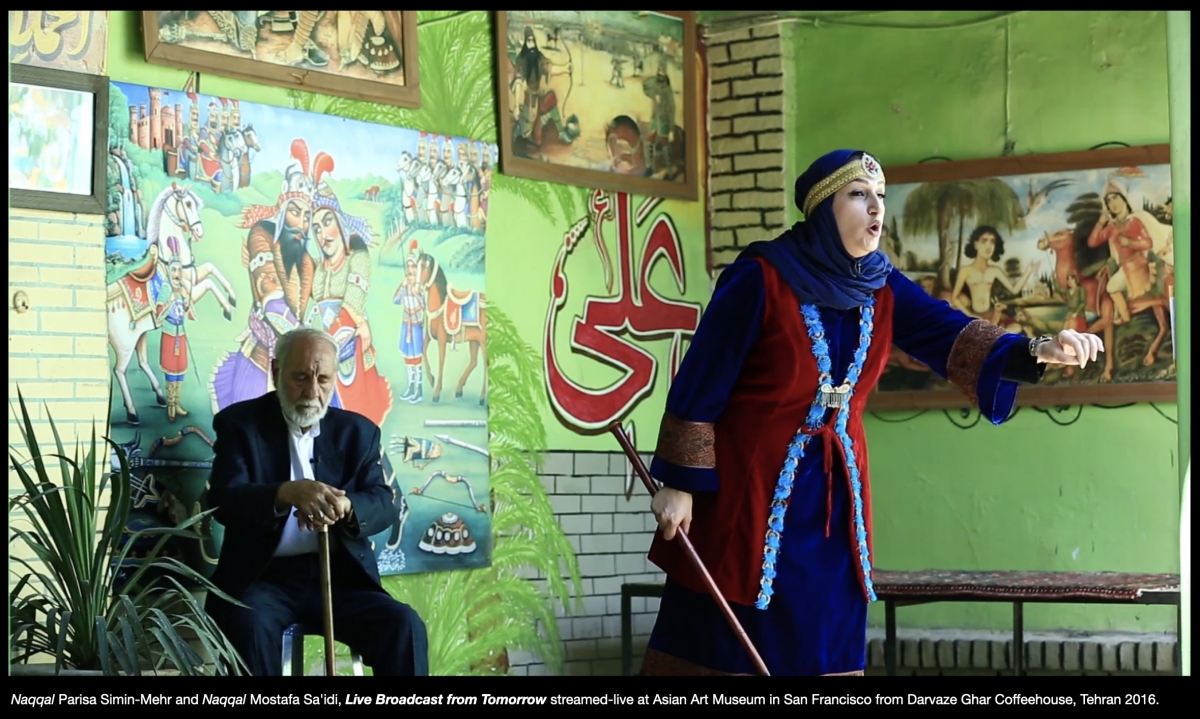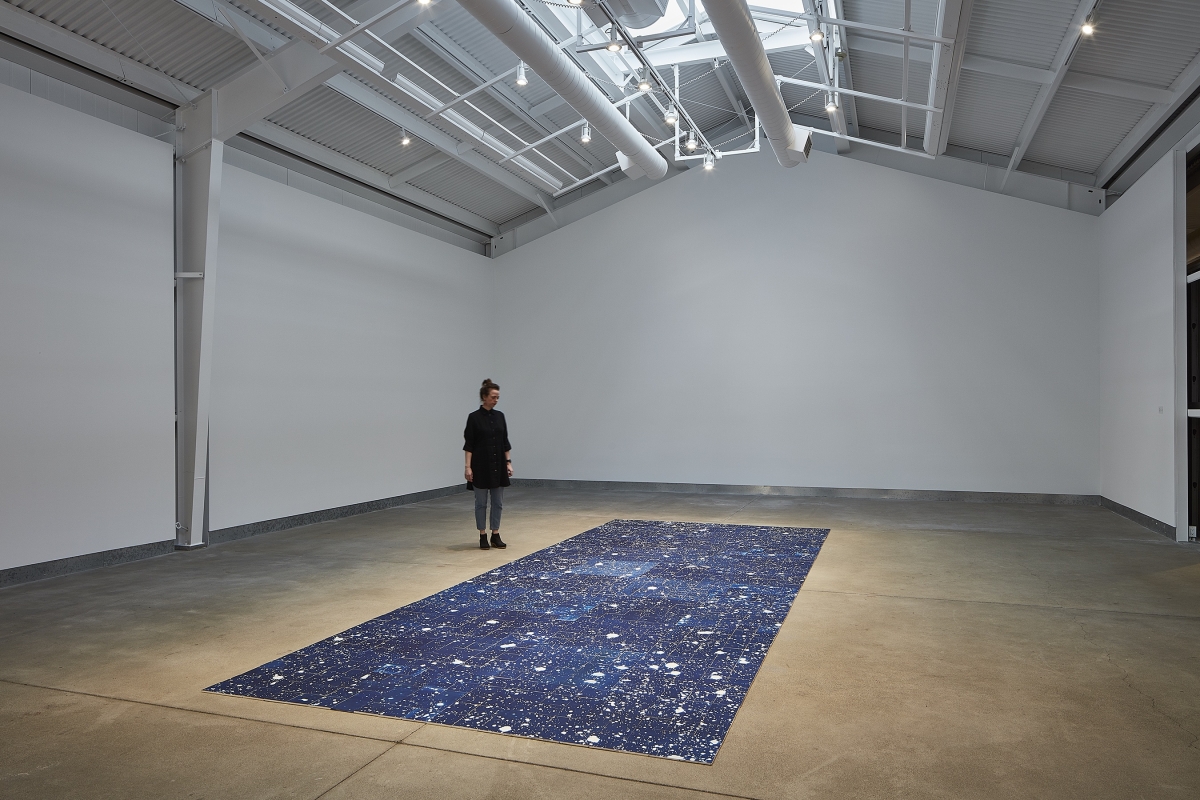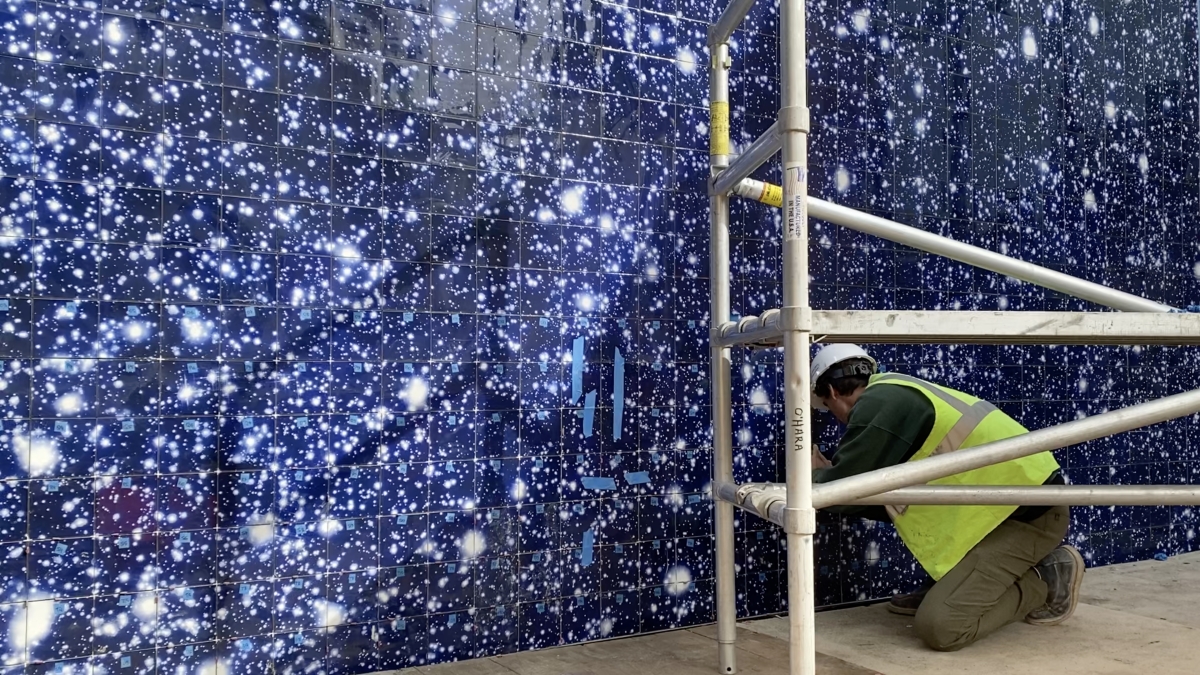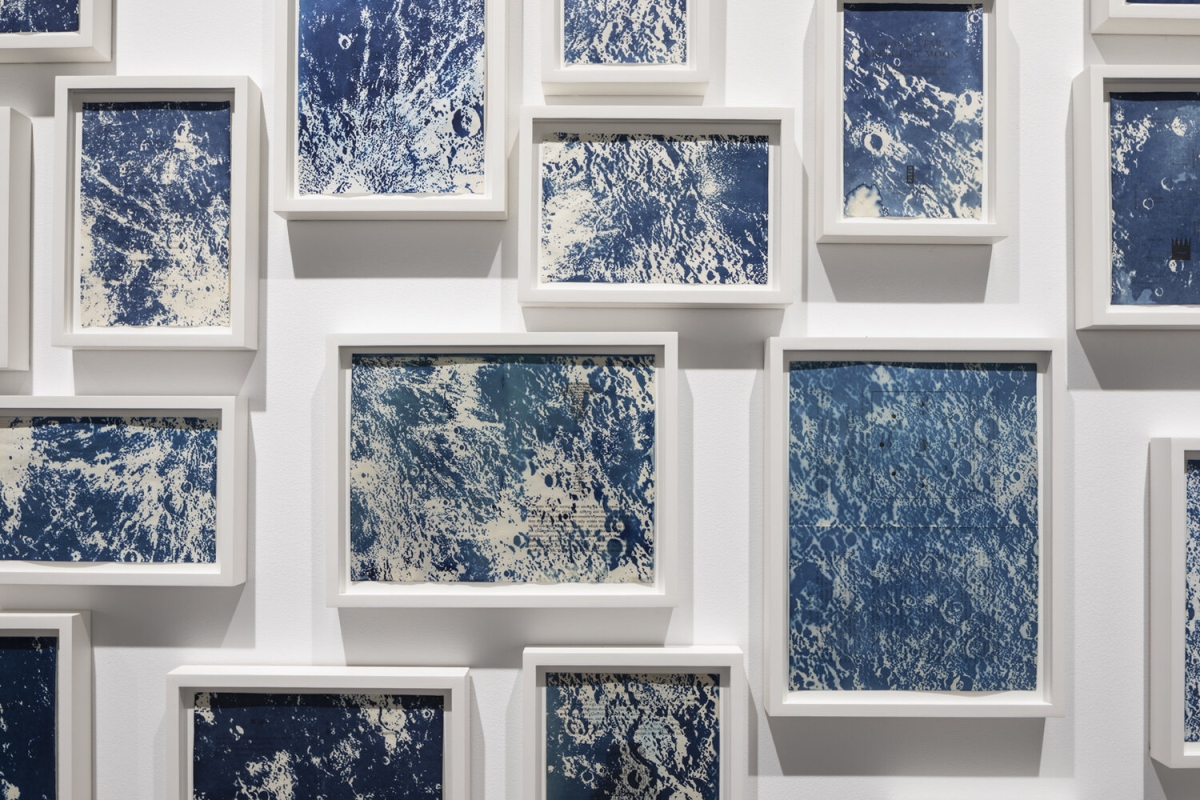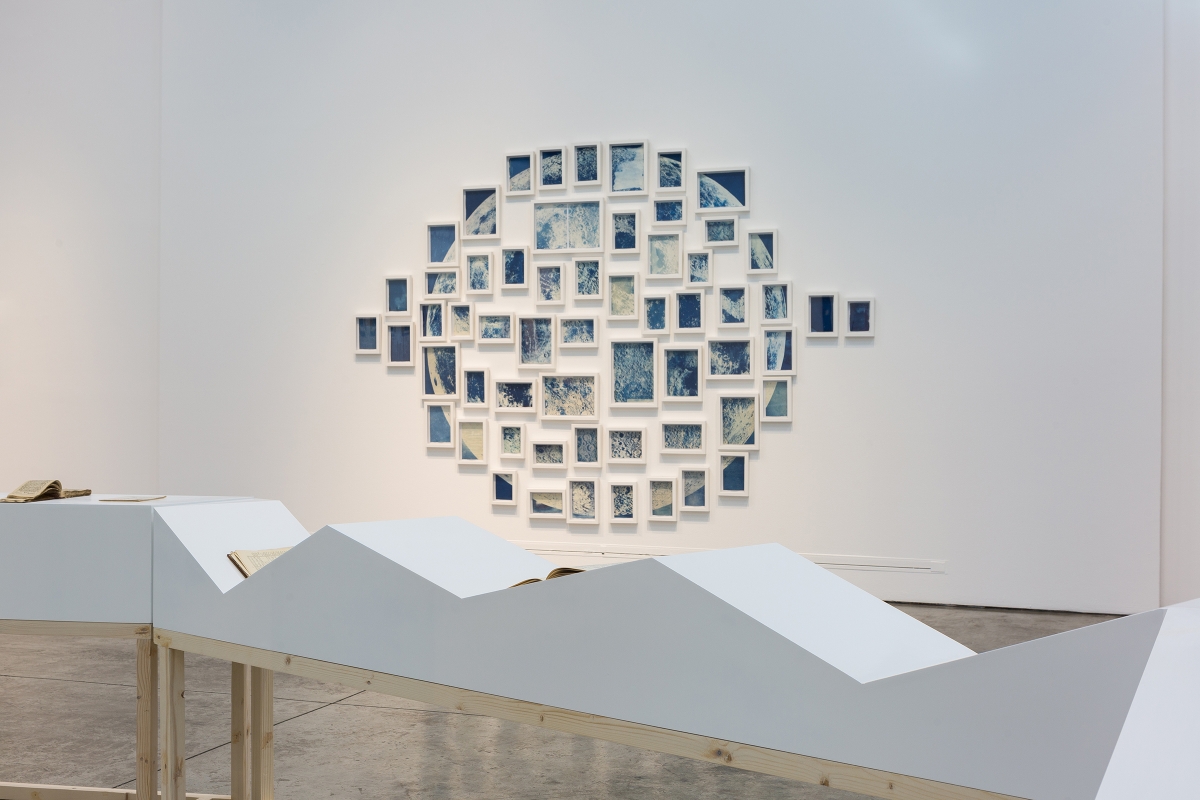The following interview began in person on the Stanford campus and has been edited for clarity and length.

Image 1: Ala Ebtekar, production shot, Luminous Ground. June 7, 2020. Photo: Layla Hashemi.
Danielle Adair [DA]: You’ve been interested in cities and painting for some time now. Let’s begin by discussing your work with murals in the East Bay. You have helped bring Iranian contemporary artists known for their public murals to the Bay Area. Can you describe that project and the work that is in Oakland?
Ala Ebtekar [AE]: Part of the key components of the initiative was to have an artists-in-residence program for longer and deeper engagements with the community here. Parham Ghalamdar [1] was our first artist-in-residence in the fall of 2016, and the mural on Broadway Street in Oakland was one of three public art projects he worked on while he was here. The other two—one was in the Mission in San Francisco and the other was on Stanford’s campus. The first few weeks he was here was just becoming familiar with the Bay Area and the U.S. It was his first time here. So we just hung out, he visited my class, we went to some friends of mine's artist studios, saw some shows, and just spent time becoming familiar with the community here. He was here for about five weeks.
During this time I connected him with Mike “BAM” Tyau [2], a local graffiti artist and member of TDK Crew, the most respected Oakland graffiti crew. I remember at some point it clicked for Parham that he had seen Mike’s work over the internet back in Iran. So he was a bit awestruck, and there was this immediate respect for Mike. We were interested in trying a collaboration. Mike often works abstractly, with color fields, and it's less letter-based. Parham, in his works on walls, often mixes aspects of street art and Iranian calligraphy. Formally speaking, we knew it could work, but obviously, you can't force these collaborations. There’s so many aspects to consider in working towards a successful collaboration, and even then you don’t know it will work. We got them together over dinner, and they immediately hit it off. The rest was completely organic, like, “Oh, we should do this wall,” and in talking with the City of Oakland and Jack London Improvement District, it all worked out very seamlessly, from the preparation to the actual painting of the mural.
Image 2: Jack London Mural: Arts, Social Space and Public Discourse, mural on Broadway (Buswell Block) in Jack London, Oakland, Mike “BAM” and Ghalamdar with students from Ebtekar's class, November 2016. Photo: Ala Ebtekar.
Image 3: Jack London Mural: Arts, Social Space and Public Discourse, mural on Broadway (Buswell Block) in Jack London, Oakland, Mike “BAM” and Ghalamdar with students from Ebtekar's class, November 2016. Photo: Ala Ebtekar.
Image 4: Jack London Mural: Arts, Social Space and Public Discourse, mural on Broadway (Buswell Block) in Jack London, Oakland, Mike “BAM” and Ghalamdar with students from Ebtekar's class, November 2016. Photo: Ala Ebtekar.
As a native of Oakland/Berkeley who grew up in the area, I have no memory of a representation from this region of the world seen through public art. Besides speaking to a younger and more diverse audience, the project helps to bring visibility to an alternative representation from Iran and the region at a time fraught with tensions and misrepresentations.
I know, for myself, growing up seeing my name on a wall felt quite empowering. And I think that may be the case for many young folks coming up, to see their name lightly scrawled or bold on a wall—especially if you feel invisible, or that nothing represented around you is “yours,” whether that be property or history. Also, it is a reminder that these cities are living cities. A city does not have to be approached as something historic that has to be cemented into a single identity. A city is a living place.
DA: You have not only studied coffeehouses in the Bay Area, you’ve also created an event of bringing an Iranian coffeehouse performance to the Bay Area with Live Broadcast from Tomorrow. I know you are also interested in the ways Persian poetry informs life in Iran. I'm wondering if you see coffeehouses as a kind of learning space. How might that play out for you in creating these projects?
Image 5: Live Broadcast from Tomorrow, still from live-streamed performance from Darvaze Ghar Coffeehouse, Tehran, at the Asian Art Museum, San Francisco, November 2, 2016.
AE: There's a few projects I've done around this, and I'm still working on some others. My first solo show was actually a coffeehouse installation, almost twenty years ago now. I see these sites as liminal spaces for the most part. They’re privately owned, but they function as this kind of free public space, blurring the boundaries of public and private. As a social space, a coffeehouse is a site in which a wide range of folks engage in conversation, resulting in the creation, exchange, and change of public discourse. Furthermore, the coffeehouse provides a pedagogical space for the negotiation of history and memory, as well as future and possibility.
Historically coffeehouses (or qahveh-khaneh in the Iranian context) were frequented by artisans and intellectuals, including scholars, poets, painters, musicians, and politicians, to gather and engage in discussion over coffee and food. Poets would recite their poems, storytellers would recite excerpts from the Shahnameh, musicians would perform pieces for the patrons, and the Sufis would preach. Apparently, according to Jean Chardin, a French jeweler who traveled to Persia in the 1600's, the degree to which freedom of speech was permitted in the coffeehouses was unique among the many places in the world he had traveled. Rumors, news, and gossip also circulated between coffeehouses, constituting the styles and types of communication that generated diverse communicative publics, relatively removed from the supervision of the state. And each coffee-house also became home to different communities: if you needed a tile maker, you'd go to the coffeehouse where all the tile makers and tile setters hung out at.
Think of the old Caffè Med on Telegraph in Berkeley. In high school, my history teacher, Stan Cardinet, had us work on an oral history project about the sixties and the Free Speech Movement. I told him “I don't know anyone alive that was around then.” he was like, go up to Caffè Med, and ask someone sitting there if they were in Berkeley during the ‘60s. And I'm like, fifteen, thinking: What do you mean go talk to someone I don't know sitting in a cafe? But sure enough, it worked out, first person I asked was there and very much active in the ‘60s student movement in Berkeley. He was kind enough to invite me, a young teenager, to sit with him for the next hour and interview him on a tape recorder I was carrying shyly. That same Caffè Med was a meeting ground for many student groups and activists over many decades, as well as some of the Beat artists and writers like [Allen] Ginsberg. I've been told some of the early hackers like Captain Crunch would also meet up there.
DA: We first met at an event you curated for the artistic group Slavs and Tatars in 2019, held at the David Rumsey Map Center at Stanford. That is apropos, as your work traverses and indexes many landscapes. Could you talk a little bit about your ongoing project Luminous Ground and the process of generating the work from its tile making to the latest iteration?
AE: There are ways to speak about this work both as a finished piece and then the many stages of the process. When a work takes two years to produce, I have to push myself to remember, “Yes, I have this relationship with this five-by-five-inch tile, but no one's going to be holding it the way I'm holding it,” not in the final installation of it. I see projects that come about, even when it's a gallery show, as an opportunity to create something that is site-specific. Even when it's a commercial gallery, I am thinking about that site, the location of it, what's explored, what kind of audiences, and how works are essentially framed or bracketed.
Luminous Ground originated as a gallery exhibition for the di Rosa Center for Contemporary Art. I essentially proposed this work after walking into the space, seeing that there's this 22-foot-by-10-foot skylight, and finding myself drawn to the light it spilled on the gallery floor in those dimensions. I thought: How can we bring attention to that, but also, how can we bring the outside inside? And how can we bring the sky to our grounds? I was hoping to create this kind of experience.
Image 6: Luminous Ground in the exhibition Be Not Still: Living in Uncertain Times (2018) at di Rosa Center for Contemporary Art, Napa, CA. Photo: Johnna Arnold.
The photographic negatives that I work with, which are deep field observations of the sky, are looking at particular regions of the sky. With the naked eye you’d see nothing. However, with a telescope they reveal faint objects by collecting the light emitted from them over the course of many days. I think on one level, the work allows us to think about time and the layers of time that are oftentimes flattened as we look at an image of the sky. It's 12 billion years of cosmic history that these negatives contain. Yet the format, especially the iteration at the museum, [3] which is 55 feet long and seven feet high, I imagine as the body walking across history. The dimensions itself in some ways for me suggest a timeline, reminiscent of many historic timeline maps which cartographers have rendered, or even scrolls. It may also be thought of like a mirror, or creating this kind of contemplative experience to look inward.
I just finished doing a smaller, permanent public art commission of Luminous Ground for the City of Oakland. It’s on a school campus, but it's open to the public. With this idea of indexing the site, I remember one of the members of the art committee that brought me into the program said, “Well, you know, the city really wants it to be an original work, and you're using the same title as at the Asian Art Museum work.” My response was, “It’s a living work.” Each iteration is different. I like that working with the same title, at this site, is an index for that. Obviously, the Asian Art Museum is the most ambitious of them all (so far), and it's taken a much different life and energy and scale, but I don't see the work as done. It will continue, but also be something new in each of these different sites.
Image 7: Luminous Ground, 2021, Ceramic tile mural, College Preparatory School, Oakland, CA. Photo: Ala Ebtekar.
DA: You refer to it as a “living work,” and I think of that in terms of context and logistics. For instance, the tiles will fade over time, the cityscape around the Asian Art Museum will change, and so the work is living in something. When we last talked, you mentioned this idea of generational time in reference to the Sather Gate at Berkeley. Could you talk about this notion and, possibly, in relation to Luminous Ground?
AE: The arch of Sather Gate spans time and history. It's a site that, obviously, is the entrance to the university, but there are multiple entrances to that university. So what is it about this one that has become such a seminal site for so many student groups and activists over the past sixty years who have chosen that gate as a site for protest—from the FSM (Free Speech Movement) and TWLF (Third World Liberation Front) of the 1960s to BLM (Black Lives Matter) of more recent years? More personally, there’s the fact I grew up playing under that arch as a young child as my parents were student activists who would often be tabling under the arch. So seeing this unfolding of time through both documented photographs of these past events and movements overlying with my own childhood memories with my father playing under that gate, is what I mean by encountering or experiencing generational time through a site or art work.
Luminous Ground is something that’s birthed by light over the course of a year. There are 12 billion years on one timeline—if you're thinking about it as a vertical axis, looking upwards the line penetrates the horizon and the layers of space and time above—and then following that same line (axis) down, it runs through the soil horizons, where you must again consider time, as the many millions of years it has taken for clay to form deep below. Even though I'm not literally talking about all the events that have happened, I feel by working with local California soil, through the material, I'm talking about what's happened on this land. And perhaps as you walk across this 55-foot-long tiled wall, imagining your body walking across history as well as looking into it may feel similar to that personal experience I have of walking under Sather Gate.
In terms of the materiality of it though, it's bisque fired clay exposed to the sun and printed through an altered cyanotype process, where it's not fully vitrified for it to still absorb some of the solution and be light-sensitive. There’s the brushing of the solution on the clay tile, in the dark, letting it dry, then bringing it out in the sun, and then when you pull it back out from the sun, there's a soaking of it in water. The washing of it fixes the process. You wash it too much, it can fade. There's a whole art of how much you put it out, how you brush it, and then how you wash it. Through time, it will fade under sunlight. There are tricks to have it rejuvenate and that's by tarping it for a week or more. Think of Christo and Jeanne-Claude’s wrapping of monuments, imagine such a scale work or wall as Luminous Ground being tarped, there’s certainly something kind of odd about that. But there is something interesting about the idea of renewal and part of that happens naturally just in the dark of every day. The work is meant to change and fade over time. It’s being sincere to what it is, and that’s part of it.
DA: Poetry and texts are very important to you, and the piece that you've created has its own story and, as you said, it’s going to tell us new stories when it fades. Could you talk about storytelling and texts in relation to your work?
AE: Over the past decade I've been really interested in how the earth and sky meet and the story that each of them tells. Our tone just naturally changes when we talk about the sky. But our tone is very different when we talk about this land. By these two meeting, you know, the formation of clay and working with soil from California, I am trying to talk about the rights to a land, about whose land this is, about the history of labor on this land, and the many aspects that are embedded in the soil, hopefully becoming part of the materiality that must be considered in the work. In other works or series, these two may meet through a kiss, or an embrace. Or maybe it’s a fall, like the crumbling of the sky that has fallen to the earth. The first iteration of Luminous Ground was attempting to do that, to shift the place of heaven and earth, by inviting us to shift the direction of our gaze, to imagine the “original gaze,” of the skies looking at us.
From my own perspective, I grew up being interested in graphic novels. But I wasn't necessarily interested in the specific stories they illustrated, but rather in the format, this idea of text and image, and this panel-by-panel narrative. Later, coming up, I got into graffiti, which is also a kind of image-text synthesis, and then being absorbed into the tradition of illumination and book arts of Iran while studying in Tehran. I think you see there is a clear connecting thread between them all, and it’s reflected in my work.
Also, within the Iranian cultural framework, text—and specifically the discourse around poetry—is very different than in the West and other countries. A good example of that can be seen through poetry manuals, something like a how-to book on writing poetry for beginners learning the medium of poetry. A story sometimes used as a preface or introduction in these manuals is a story and poem of Rudaki, who was a ninth-century Persian court poet. The story is about Amir Nasr Samani who leaves his home in Bukhara, for a seasonal retreat or vacation, but delays his return to the city due to liking the vacation site so much. Everyone from the vizier to the amir’s closest confidants try to get the king to return home, but all are unsuccessful. Out of desperation, the vizier asks the court poet, Rudaki, to convince the amir somehow. Rudaki writes and recites a poem for the Amir about the glorious reunion, and in his beautiful way describes this journey of reunion home to the city of Bukhara. The amir, upon hearing the last line of the poem, becomes homesick and, in a storm, jumps on the saddle of his horse and returns home to Bukhara that very night. I think the fact that this is used as a preface in how to write poetry books, is quite significant, in allowing us, or those who embark on the path to becoming poets, to see the potential power of poetry. The army, the commander, the sergeant, the vizier, and court, can’t make the king budge but a few verses recited have the king running back to the city.
I see that relationship people have with poems and specific poets, whether it be read, heard, or seen painted on a wall. People live with Hafiz, reciting his poems and asking the most personal or mundane questions, as augury. Ferdowsi, Rumi, Attar, Saadi, Hafiz, Khayyam, although centuries apart, all live alongside one another in the present moment in the collective consciousness of the Iranian people, speaking in a language well understood today. I think maybe I'm affected by it in the same way, and how poets and texts written centuries apart can be in dialogue with one another. Thirty-six Views of the Moon is one of them, where Khayyam writes, “look up at the moon.” [4] I was thinking about that poem for a few years prior. Even Luminous Ground was prompted by it in some ways. So I think it happens in different orders; in some ways I also see it as a sort of re-enactment of the text.
Image 8: Thirty-six Views of the Moon (detail) at McEvoy Foundation for the Arts, San Francisco, CA, May 24 –September 7, 2019. Photo: Henrik Kam.
Image 9: Ala Ebtekar, Safina 2018 Installation view, Thirty-six Views of the Moon at The Third Line, Dubai, UAE, November 12–December 27, 2018.
My work is definitely not done with exploring different aspects of these sites. It's an ongoing thing. More personally, it's also how I settle in a new environment. The first place you'll catch me when visiting a new town or city is usually a local coffeehouse, sipping on whatever drink and maybe a pastry, and just kind of absorbing the city through sitting at that cafe.
It's interesting how we talk about the city and navigating the city, even going back to that Rudaki poem, and saying the Amir swiftly jumps on horseback without riding shoes heading home, all prompted from hearing the description of the city.
Notes
[1] Parham Ghalamdar is an Iranian contemporary artist. His work can be found here: https://www.ghalamdar.com/.
[2] Mike “Bam” Tyau is a contemporary artist and teacher based in the Bay Area. His work can be found here: https://miketyau.com/home.html.
[3] Asian Art Museum, San Francisco, an outdoor installation on the museum’s art terrace, set to open spring 2022.
[4] “Drink wine and look at the moon and think of all the civilizations the moon has seen passing by.”—Omar Khayyam, 11th century mathematician, astronomer, and poet.



